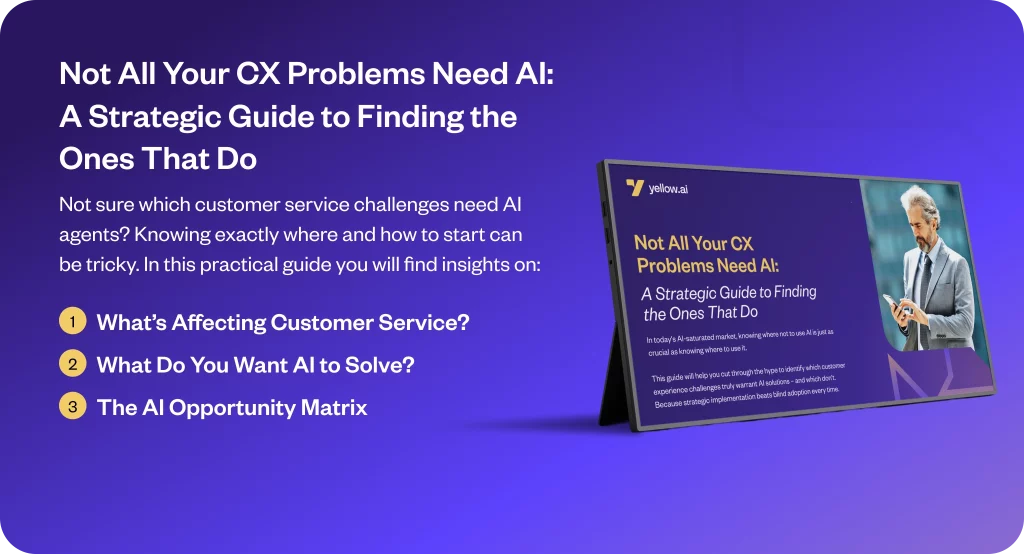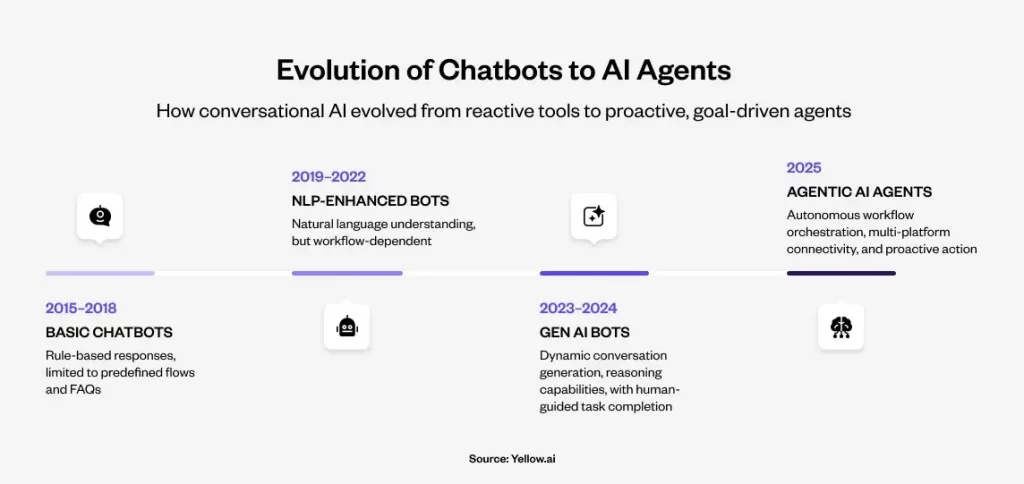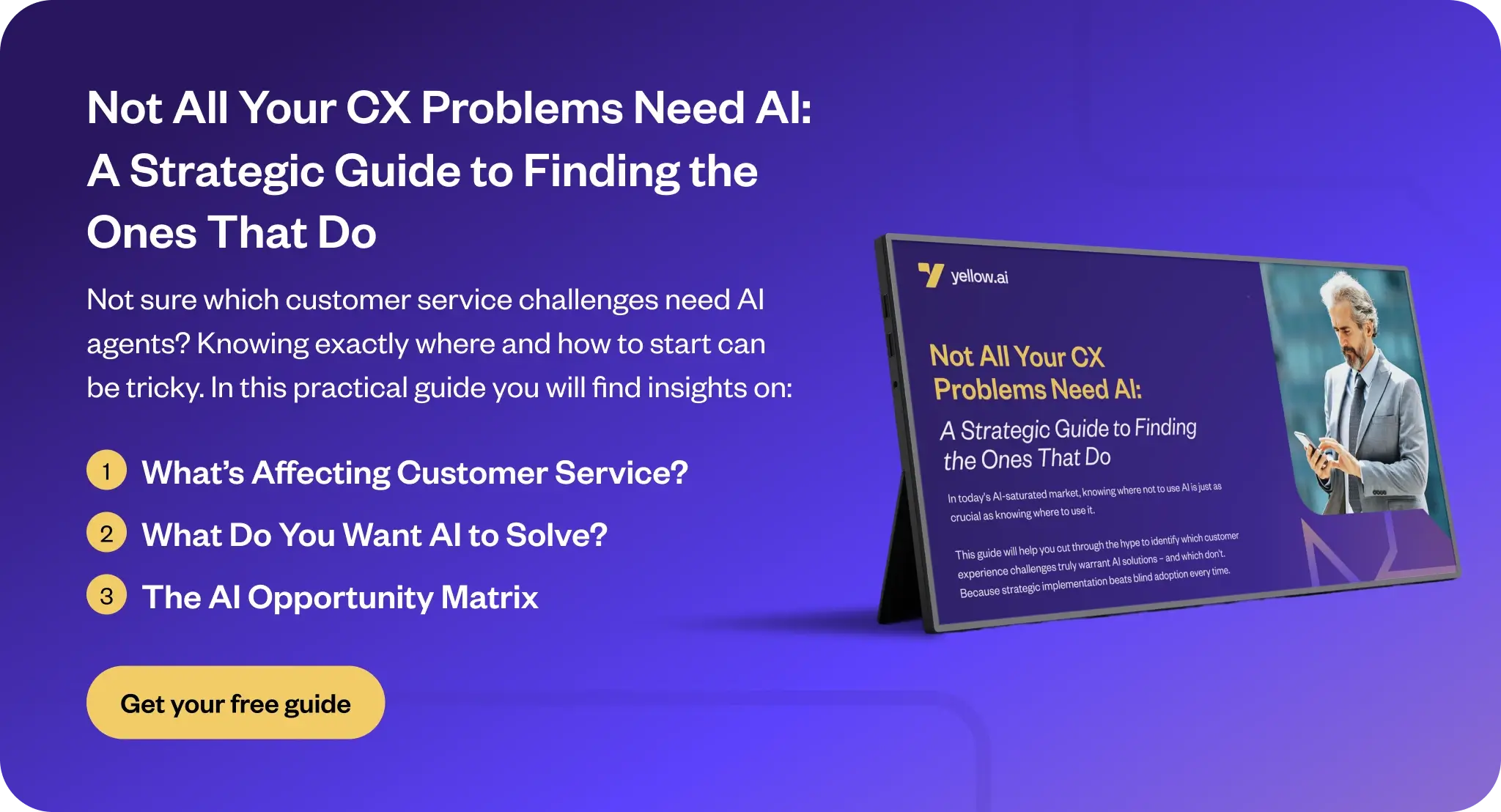In a rush and need the TL/DR version?
Executive Summary
Over the past decade, enterprise automation has evolved dramatically: from rigid chatbots to conversational AI, to today’s Agentic AI agents that reason, remember, and act. But with every leap in capability comes a new wave of confusion: What’s the difference between a chatbot, a GenAI assistant, and an AI agent? How should enterprises decide what they really need?
In this guide, you’ll learn:
- What are AI agents and how they’re fundamentally different from traditional bots
- Why Agentic AI is becoming the new standard for enterprise automation
- How AI agents work: reasoning, memory, orchestration, and autonomy
- Benefits of AI agents across functional use cases and industries
- Real-world examples from enterprises already deploying AI agents at scale
- What to look for when choosing an enterprise-grade AI platform
- And a thoughtful (and ironic) reminder: not every CX problem needs an AI agent. Find the right ones that do
Whether you’re just starting your AI journey or re-evaluating your automation stack, this guide is a foundational step in that journey.
Note: This summary is not a substitute for reading the article in full, as you may miss out on important nuances.
What are AI Agents?
AI agents are software systems that can understand a user’s intent, make decisions, and take action, all on their own. They don’t just respond to instructions. They work toward a goal, acting independently or with minimal input, often using large language models (LLMs), planning algorithms, and memory systems.
You can think of an AI agent as more than just a chatbot or a smart assistant. Where traditional chatbots follow scripts, and assistants react to queries, agents are built to do. They reason through multi-step tasks, interact with tools, access information from memory, and adapt based on context, just like a skilled human agent would.
At their core, AI agents combine three foundational capabilities:
- Planning: breaking down problems into steps and deciding how to approach them
- Tool use: interacting with APIs, databases, or third-party systems to complete tasks
- Memory: remembering prior conversations or facts to improve relevance and continuity
These systems are often used to automate service workflows, guide customers through complex issues, or proactively solve problems without needing a handoff to a human.

As enterprise needs grow more complex, spanning multiple systems, languages, and workflows, AI agents are becoming the gold standard for scalable, intelligent automation.
AI Agents vs Chatbots vs Generative AI: What Enterprises Must Understand
We’ve talked about AI agents but here’s where most leaders (understandably) get stuck:
“Aren’t they just more advanced chatbots?”
“They’re just smarter assistants powered by GenAI?”
“They’re like ChatGPT for X”
The answer is: not quite. And this distinction matters.
Over the past decade, we’ve seen automation move through four major phases: from rule-based bots to truly autonomous, agentic AI systems. Each step has added layers of intelligence, flexibility, and actionability. But not all AI is created equal.
Let’s break it down:
- Basic Chatbots were the first wave. Rule-based systems that followed scripted flows. Great for FAQs, but brittle beyond that.
- Conversational AI brought Natural Language Processing (NLP) powered improvements, enabling bots to understand and respond more naturally. Still, they remained reactive.
- Generative AI Bots introduced human-like fluency using Large Language Models (LLMs), able to generate content and engage in dynamic conversations. But they lacked goals, memory, or the ability to act.
- Agentic AI Agents represent the next leap, proactive, decision-making systems that can plan, reason, and act across enterprise systems without constant prompts. They’re not just better talkers, they’re doers.
Unlike AI assistants, which require clear instructions and human oversight, AI agents can self-initiate action. They break tasks into subtasks, make autonomous decisions, and continuously learn from outcomes. This shift, from reactive to proactive, is what makes them “agentic”. In this blog, when we refer to AI agents, we’re referring to Agentic AI agents.

Related read: From Chatbots to AI Agents: The Next Evolution in Enterprise Automation
How AI Agents Work?
Behind the scenes, AI agents follow a structured workflow to solve problems and complete tasks, often without human intervention. While the interface might look like a simple chat window, what happens underneath is far more dynamic.
Here’s how it works.
1. Goal Initialization
Every agent starts with a goal: a user’s request, a system trigger, or an automated rule. This could be as simple as “Check delivery status” or as complex as “Recommend a personalized loan”. The agent receives the goal and translates it into a series of actionable steps.
If the goal is complex, the agent breaks it down into smaller subtasks. This is where planning kicks in. It determines the best route to achieve the objective, similar to how a human agent might outline the steps before tackling a project.
2. Tool Access and Information Gathering
Most AI agents aren’t all-knowing and the best ones don’t pretend to be. To act effectively, they reach out to tools and systems to gather real-time information.
These tools might include:
- APIs (e.g., CRM, order management, weather databases)
- External agents or knowledge retrieval systems
- Web search functions or custom datasets
This is what sets agents apart from static chatbots: they can access live data, query systems, and use those results to inform their next move.
3. Task Execution and Adaptation
With a plan in place and data in hand, the agent begins acting on the subtasks. It executes one step at a time: say, sending an email, updating a record, or initiating a support ticket, all in seconds.
4. Learning and Personalization
Over time, agents remember. They store user preferences, successful paths, and failed attempts in short-term or long-term memory systems. This memory improves personalization and reduces friction the next time the user returns.
Most systems also incorporate feedback loops (from human agents or other AI agents) to improve accuracy over time. This is often called iterative refinement, and it helps AI agents get smarter with use.
Benefits of AI Agents for Enterprises
So far, we’ve covered what AI agents are and how they differ from chatbots, LLMs, and virtual assistants (or the dozen other terms they often get confused with). Let’s now talk about why they matter.
Here are the four core benefits of AI agents for enterprises:
1. Automate Complex Tasks End-to-End
AI agents go beyond scripts. They can break a user goal into smaller tasks, plan the best path forward, and complete the entire workflow, all without human hand-holding. For complex queries, they can work with your human agents, providing contextual handovers that ensure smooth end user experiences.
Why this matters: It eliminates manual triaging, reduces response time, and improves consistency, especially for high-volume queries, thus freeing up your human agents for more complex tasks.
2. Deliver Personalization at Scale
Memory is a foundational capability of every AI agent, using which AI agents can remember past interactions, user preferences, and resolution paths. This enables far richer, more relevant experiences for the end users than traditional bots ever could deliver.
For example, if a returning customer says “I want to reorder,” an AI agent can instantly reference their last purchase, suggest related items, and complete the order within the same conversation.
Why this matters: In a recent Mckinsey report, The value of getting personalization right—or wrong—is multiplying, 76% of consumers get frustrated when they don’t find personalization. In such a low-loyalty environment, non-personalized communications and experiences pose a significant business risk.
3. Boost Productivity and Efficiency
Unlike humans, AI agents can operate 24/7, handle thousands of conversations simultaneously, and self-correct as they go. They don’t get tired, overwhelmed, or inconsistent.
This makes them ideal for:
- Handling repetitive tasks (password resets, order tracking, claim filing)
- Resolving tier-1 queries without escalation
- Supporting internal teams with on-demand answers, contextual handovers, and freeing time for more complex tasks
- Cutting operational costs without compromising quality
Why this matters: Lion Parcel, a leader in the logistics industry, elevated customer convenience and efficiency by achieving 85% query automation using their Gen AI Agent.
4. Improve Decision-Making with Real-Time Data
AI agents can access external tools, APIs, and databases to gather context, then make decisions based on that live input.
For example:
- A financial services agent checks credit data and spending history before recommending loan options.
- A retail agent queries live inventory before offering replacements during a return.
Why this matters: Unlike static chatbots, AI agents use dynamic context to offer smarter, more precise responses, driving better business outcomes.
AI Agent Use Cases (For Enterprises)
From the last few sections, it’s clear that AI agents are not “just another layer of automation”. By combining reasoning, memory, and action capabilities, they solve problems that traditionally spanned multiple systems, teams, or tools. The best part? They can do this proactively, without needing human intervention.
Function-Based Use Cases (Horizontal solutions)
- Customer Support & Service: Handle full customer journeys such as verifying identity, resolving issues, and escalating as needed and across channels (chat, voice, email, and more).
- Contact Center Agent Productivity: Summarize past interactions, draft personalized replies, contextual handovers, and auto-complete ticket actions to reduce average handle time.
- Employee Experience & Internal Ops: Reset passwords, fetch policy documents, and manage HR requests directly inside Slack or Teams, no tickets required.
- Sales & Marketing: Auto-track campaign KPIs, recommend follow-ups in CRM, and generate personalized outreach using customer history.
- Finance & Procurement: Approve expenses, respond to payroll queries, and flag anomalies in spend, securely and autonomously.
- IT Helpdesk: Resolve routine issues like VPN errors or software requests without clogging up the service desk queue.
Industry-Specific Applications (Vertical solutions)
- BFSI: AI agents assist in loan processing, KYC verification, and policyholder servicing, across channels, with audit-ready logs.
- Retail & E-commerce: Help customers track orders, process returns, and recommend products based on purchase history and real-time inventory.
- Utilities: Manage outage updates, billing queries, and service requests with 24/7 multilingual support across voice and digital channels.
- Healthcare Assist patients with appointment scheduling, pre-visit forms, and post-discharge instructions, while maintaining compliance.
- Telecom: Handle SIM activation, plan upgrades, and troubleshooting without routing to live agents, reducing support costs and boosting agent productivity.
- Education: Support student onboarding, course FAQs, and fee management through AI agents integrated into campus apps or portals.
How to Choose the Right AI Platform for Enterprise Automation
Not all AI platforms are built for enterprise complexity. Some excel at general-purpose conversations (like ChatGPT), while others claim agentic capabilities but fall short on execution. If you’re evaluating AI for customer service, IT automation, or internal ops, here’s what to look for in a true enterprise-grade AI platform.
1. Agentic Architecture, Not Just Chat Interfaces
Look beyond bots that answer questions. True platforms should support AI agents: autonomous systems that reason, plan, and act. Ask:
- Can it execute tasks, not just respond?
- Does it support agent workflows beyond chat (email, voice, backend systems)?
2. Multi-Channel & Multi-Modal Support
Enterprise AI needs to work everywhere (not just answer FAQs on a website). Look for platforms that offer:
- Multiple channels (Chat, voice, email, social)
- Multimodality (inputs as text, voice, images, documents, etc.)
- APIs, CRM integrations, and app embeds
- Multilingual support and speech-to-text for accessibility
3. Enterprise-Grade Orchestration
“Agency” refers to the ability to intentionally make something happen based on one’s actions. AI agents in the enterprise context must orchestrate real outcomes. Evaluate whether the platform can:
- Trigger workflows across systems (like SAP, Salesforce, ServiceNow, etc.)
- Update data, escalate issues, and complete transactions autonomously
4. Memory, Context, and Reasoning
We have already seen how memory, context, and advanced reasoning are key differentiators that separate traditional chatbots from AI agents. Your AI platform vendor should offer:
- Persistent memory across sessions
- Contextual understanding across channels
- Ability to break down complex tasks into subtasks and resolve them
5. Security, Compliance, and Governance
While this point seems obvious, it’s even more pivotal for heavily-regulated industries such as BFSI, healthcare, and telecom. Your enterprise AI vendor must offer a secure, compliant and auditable platform. The non-negotiables include:
- Role-based access controls
- GDPR, SOC2, HIPAA compliance
- Audit trails for every AI-driven interaction
6. Extensibility & Customization
Enterprise problems are rarely simple. Then why should you invest in cookie-cutter AI solutions? The right AI vendor is a partner in your digital transformation journey. Ask:
- How can we identify and scale the right use cases?
- Can we build and deploy custom agents quickly? What’s the time to go-live?
- Is there a low-code/no-code environment for business users?
- Does it support external tool/plugin integration (e.g. retrieval-augmented generation, copilots, agent teams)?
7. Proven Use Cases & References
If your AI vendor is “live” with “pilot projects”, it’s rarely a good place for your enterprise to start. Enterprise AI should deliver outcomes, not experiments. Ask your vendor:
- What does success look like? What are the north star metrics to track?
- What quantifiable impact have you delivered for customers in our industry/horizontal use case?
- Which enterprises trust you for mission-critical automation? How many deployments in the last 2 quarters?
- Can we speak to a reference? (Non-negotiable)
Conclusion
AI agents aren’t just an evolution of chatbots: they represent a paradigm shift in how enterprises today are approaching automation. From resolving complex support issues to powering internal operations and cross-channel workflows, AI agents offer a level of intelligence, autonomy, and orchestration that traditional bots and GenAI tools just can’t match.
But here’s the kicker: not every business challenge needs an AI agent. The key is knowing where they drive real impact (repetitive workflows, multi-system journeys, or tasks that require memory, reasoning, and action).
At Yellow.ai, we help enterprises identify those high-impact opportunities, strategize the right AI roadmap, and bring the AI agents to life.
Wish to explore what agentic automation could look like in your organization? Start with our free diagnostic guide.

Or, if you’re ready to see it in action, book a custom demo here.
Frequently Asked Questions (FAQs) about AI Agents
What is the difference between AI agents and chatbots?
While chatbots follow pre-defined rules or scripts to respond to queries, AI agents go several steps further. They portray “Agency” i.e. they can reason, remember past interactions, and take actions across systems, just like a human agent would. Unlike traditional chatbots that just answer questions reactively, AI agents are proactive and task-completing.
How do AI agents work in enterprise settings?
AI agents in the enterprise are built to handle real-world complexity. They combine conversational interfaces (chat, voice, email) with backend orchestration, enabling them to update records, trigger workflows, or escalate tickets automatically, all while maintaining context across systems and sessions.
What is Agentic AI, and why does it matter?
Agentic AI refers to systems that not only understand but also act with autonomy. These agents break tasks into subtasks, make real-time decisions, and operate independently across enterprise layers. It’s what transforms an AI from being a responder (traditional chatbots) to a doer (Agentic AI agents).
Which industries benefit the most from AI agents?
Industries with high complexity, volume, or regulatory demands see the most value. BFSI, retail, healthcare, telecom, utilities, and ITSM, are top verticals that have seen the most impact with AI. Whether it’s automating claims, managing returns, or resolving service requests, AI agents deliver measurable gains at scale.
How do I choose the right AI platform for my business?
Start by checking if the platform supports true AI agents, not just chatbots/GPT wrappers. Demand orchestration capabilities, cross-channel support, memory, reasoning, security, and proven outcomes in your industry. A good AI vendor is outcome-focused and a strategic partner in your enterprise automation journey.
Are AI agents secure and compliant for regulated industries?
Yes! Enterprise-grade AI platforms offer role-based access, audit logs, and compliance across SOC2, GDPR, HIPAA, and more. The right AI vendor ensures every interaction is secure, traceable, and meets the industry’s strictest governance requirements.

























